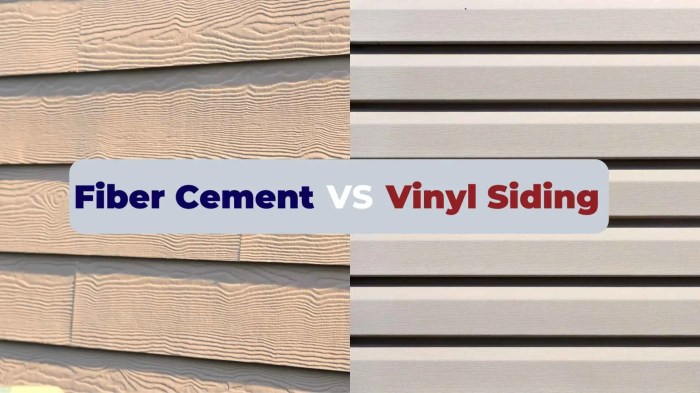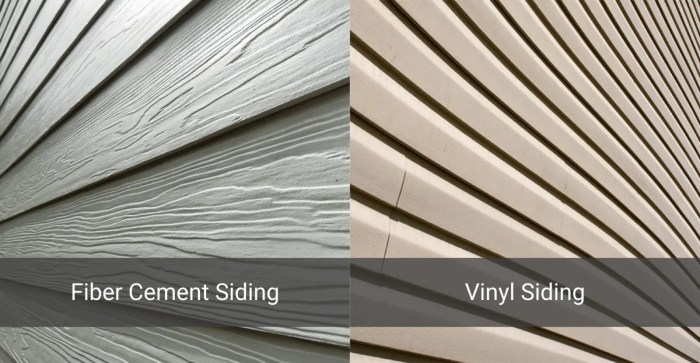As Vinyl vs fiber cement siding: Pros and cons takes center stage, this opening passage beckons readers with casual formal language style into a world crafted with good knowledge, ensuring a reading experience that is both absorbing and distinctly original.
When it comes to choosing between vinyl and fiber cement siding, there are several factors to consider. From durability to maintenance and cost-effectiveness, each type has its own advantages and drawbacks. Let's delve deeper into the comparison to help you make an informed decision for your property.
Vinyl Siding

Vinyl siding is a popular choice for homeowners due to its durability, low maintenance requirements, cost-effectiveness, and variety of styles and colors available.
Durability
Vinyl siding is known for its durability, as it is resistant to rot, moisture, and pests. It can withstand harsh weather conditions, such as extreme heat and cold, without warping or fading over time.
Maintenance Requirements
One of the key advantages of vinyl siding is its minimal maintenance requirements. Unlike fiber cement siding, which may require repainting or resealing, vinyl siding simply needs occasional cleaning with a hose and mild detergent to maintain its appearance.
Cost-Effectiveness
Vinyl siding is a cost-effective option for homeowners, as it is generally more affordable than fiber cement siding in terms of initial installation costs. Additionally, the low maintenance requirements of vinyl siding can lead to long-term cost savings compared to other siding materials.
Styles and Colors
Vinyl siding offers a wide range of styles and colors to choose from, allowing homeowners to customize their exterior look to suit their preferences. Whether you prefer traditional clapboard siding or modern board and batten designs, vinyl siding provides versatility in aesthetics.
Fiber Cement Siding

Fiber cement siding is a popular choice for homeowners looking for a durable and low-maintenance option for their homes. It is made from a mixture of cement, sand, and cellulose fibers, offering a strong and long-lasting exterior cladding solution.
Environmental Impact
Fiber cement siding is considered a more environmentally friendly option compared to vinyl siding. It is a sustainable material that can be recycled and does not release harmful chemicals into the environment during its lifespan.
Installation Process
The installation process for fiber cement siding requires precision and expertise. It involves cutting the siding to fit the specific dimensions of the property, securing it to the exterior walls, and finishing with paint or sealant for added protection against the elements.
Insulating Properties
Fiber cement siding provides better insulation compared to vinyl siding. Its dense composition helps regulate indoor temperatures, reducing energy costs and improving overall comfort within the home.
Long-Term Value
Choosing fiber cement siding for a property can increase its value over time. This siding option is known for its durability and resistance to elements like fire, pests, and moisture, making it a worthwhile investment for homeowners looking for a lasting exterior solution.
Aesthetics and Design
When it comes to the aesthetics and design of your home, the choice of siding can play a significant role in enhancing its overall appeal. Both vinyl and fiber cement siding offer unique design possibilities that can complement different architectural styles and elevate the look of your property.
Architectural Styles Complementing Vinyl Siding
Vinyl siding is a popular choice for various architectural styles, including Colonial, Cape Cod, Ranch, and Victorian homes. Its versatility allows it to mimic the look of traditional wood siding while offering a wide range of colors to suit different design preferences
Texture Options of Fiber Cement Siding
Fiber cement siding provides homeowners with an array of texture options, such as smooth, wood grain, or stucco finishes. These textures can add depth and visual interest to a home's exterior, creating a dynamic look that enhances curb appeal.
Customization Possibilities
Both vinyl and fiber cement siding can be customized to meet specific design requirements. Vinyl siding can be found in various profiles, such as horizontal or vertical panels, scallops, shakes, or shingles. On the other hand, fiber cement siding can be painted in different colors to match the homeowner's vision for their property.
Impact on Property’s Look and Feel
The choice of siding can significantly impact the overall look and feel of a property. Vinyl siding, with its clean lines and color options, can give a home a fresh and modern appearance. In contrast, fiber cement siding, with its durability and texture options, can add character and charm to a property's exterior.
Maintenance and Repairs
When it comes to maintaining and repairing siding, both vinyl and fiber cement options have their own set of requirements and challenges.
Maintenance Tasks
- For vinyl siding, regular cleaning with a mild detergent and water is usually sufficient to keep it looking good. It may need occasional painting or sealing to prevent fading or damage.
- Fiber cement siding requires less maintenance overall but should be inspected annually for any signs of damage or deterioration. Repainting may be necessary every 5-7 years.
Common Issues and Solutions
- Vinyl siding may crack, warp, or fade over time. Repair these issues by replacing damaged panels and ensuring proper installation to prevent future problems.
- Fiber cement siding can experience moisture-related issues like rot or mildew. Address these by fixing leaks, maintaining proper ventilation, and promptly replacing damaged sections.
Lifespan and Preservation
- Vinyl siding typically lasts 20-40 years, while fiber cement siding can last 30-50 years with proper care.
- To preserve the appearance and functionality of vinyl siding, avoid using harsh chemicals, power washing at high pressures, or hanging heavy objects on it. For fiber cement siding, ensure proper caulking, painting, and regular inspections to maintain its longevity.
Closing Notes
In conclusion, the debate between Vinyl vs fiber cement siding: Pros and cons offers a nuanced look at these popular siding options. By weighing the benefits and downsides of each material, homeowners can make a well-informed choice that suits their needs and preferences.
Whether you prioritize durability, aesthetics, or environmental impact, both vinyl and fiber cement siding have unique qualities worth considering for your next home improvement project.
Helpful Answers
Is vinyl siding more cost-effective than fiber cement siding?
Yes, vinyl siding is generally more affordable upfront compared to fiber cement siding. However, fiber cement siding may offer better long-term value due to its durability and low maintenance requirements.
Which type of siding is more environmentally friendly, vinyl, or fiber cement?
Fiber cement siding is considered more environmentally friendly than vinyl siding as it is made from sustainable materials like wood fibers and cement.
How do I address common maintenance issues with vinyl siding?
For vinyl siding, common maintenance tasks include regular cleaning with a mild detergent, inspecting for damage, and addressing any issues promptly to prevent further damage.
What are the insulating properties of fiber cement siding compared to vinyl siding?
Fiber cement siding typically has better insulating properties than vinyl siding, helping to improve energy efficiency in a home.


